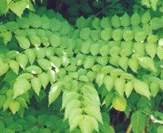|
|
|
|
|
Devil's Walking Stick
|
|
|
|
 Scientific Name: Aralia spinosa Scientific Name: Aralia spinosa
Common Name: Devil's Walking Stick
Other Common Names:
Angelica Tree, Angelica-tree,
Devil's Walking Stick, Devil's Walkingstick, Devil's walking stick, False Prickly
Ash, Hercule's Club, Hercules Club, Hercules' Club, Prickly Ash, Prickly Elder,
Toothache Tree
Plant Type: Perennial
Where To Plant: Full Sun to Partly Shady
Soil Types: Average
Zones (See US Zone map): 3-9
Germination: Hard
Number of Seeds Per Pack: 100
Uses: Medicinal
Notes: Antirheumatic and Dental obtundant. Order and sow in the Fall
or Winter.
ARALIA SPINOSA. Also know as Prickly elder, Angelica tree, Hercules' club, Toothache bush or tree. The Aralia spinosa is a small tree, growing to about 30 feet. Best suited for zones 4-9. The leaves are very large and long, often 3 to 6 feet in length, prickly, bipinnate, and borne on long, prickly petioles. The flowers are white, and disposed in numerous umbels, forming a very large panicle. The involucres are small and few-leaved. The fruit consists of blackish, juicy berries. The aralia spinosa inhabits the United States in various parts, from Pennsylvania to Louisiana, and westward to Missouri, growing in damp and rich woods and fields. The thin, ash-colored bark is the part used, although other parts of the plant possess medicinal properties; it has a peculiar, somewhat fragrant odor, and a slightly bitter, biting taste; alcohol or water extracts its properties. It is frequently grown in the Northern States for ornamentation. It blooms in August and September.
BEST SOWN IN FALL OR WINTER.
Order Devils Walking Stick seeds on Amazon
*These seeds are being sold on Amazon. As an Amazon Associate I earn from qualifying purchases.
Any statement made concerning medical
conditions treated with this herb is not intended as sound medical advice. The
seeds are NOT to be ingested only planted. Herbs need to taken only with
the guidance of a trained physician or established herblist.
|
|
|